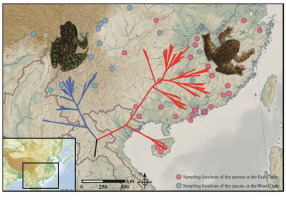当前位置:
X-MOL 学术
›
Mol. Phylogenet. Evol.
›
论文详情
Our official English website, www.x-mol.net, welcomes your
feedback! (Note: you will need to create a separate account there.)
Phylogenetic relationships of the Chinese torrent frogs (Ranidae: Amolops) revealed by phylogenomic analyses of AFLP-Capture data.
Molecular Phylogenetics and Evolution ( IF 3.6 ) Pub Date : 2020-02-03 , DOI: 10.1016/j.ympev.2020.106753 Zhaochi Zeng 1 , Dan Liang 1 , Jiaxuan Li 1 , Zhitong Lyu 1 , Yingyong Wang 1 , Peng Zhang 1
Molecular Phylogenetics and Evolution ( IF 3.6 ) Pub Date : 2020-02-03 , DOI: 10.1016/j.ympev.2020.106753 Zhaochi Zeng 1 , Dan Liang 1 , Jiaxuan Li 1 , Zhitong Lyu 1 , Yingyong Wang 1 , Peng Zhang 1
Affiliation

|
The torrent frog genus Amolops contains nearly sixty species distributed in swift mountain streams throughout southeast Asia. The taxonomy of this genus has proven complicated due to unstable morphological diagnostic characters. The relationships of Amolops species and species groups were not readily resolved with a small number of molecular markers. Here, we applied the novel AFLP-Capture approach and acquired two large datasets (242 anonymous nuclear sequences and the mitochondrial genome) from 70 Chinese Amolops samples to study their relationships. The phylogenies inferred from the nuclear data and the mitochondrial data were both robust and revealed a primary phylogenetic split between eastern and western Chinese Amolops species. The relationships of the six species groups were clarified. While the three species groups in east China (the A. ricketti, A. daiyunensis and A. hainanensis groups) were monophyletic, the three species groups in the west (the A. mantzorum, A. monticola and A. marmoratus groups) were not monophyletic, suggesting a need for further investigation and revision. The robust phylogenies also provided new insights into species relationships, especially for the A. mantzorum group, which has been difficult to resolve due to multiple speciation events occurring approximately 7-8 million years ago. The divergence times estimated with the nuclear data indicated that the ancestor of the Chinese Amolops appeared in the late Eocene or early Oligocene, and that speciation events in the Chinese Amolops were often related to geological events (e.g. the uprising of mountains and the formation of islands). By including the mitochondrial sequences from GenBank, a more comprehensive Amolops phylogeny was constructed that reflected the origin of the Chinese Amolops. Based on all these results, a dispersal scenario of the torrent frogs was hypothesized. Our research serves as the first example of using AFLP-Capture to obtain a large amount of data for shallow-scale phylogenetic and taxonomic studies, which should be useful for other nonmodel organism groups.
更新日期:2020-02-03











































 京公网安备 11010802027423号
京公网安备 11010802027423号